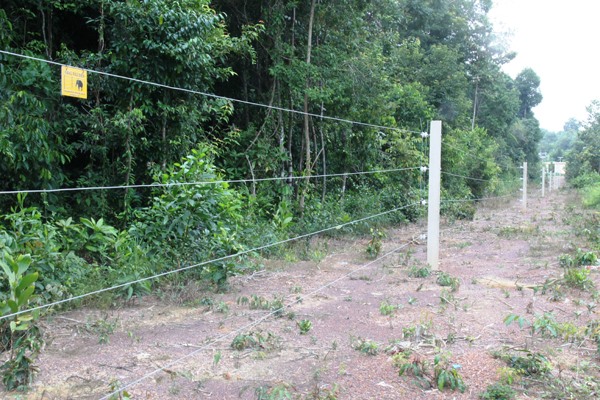[ad_1]
While the erection of an electric fence has proven effective in resolving conflicts between wild elephants and people in this southeastern province, it is not a long-term solution, experts said.

The electric fence helps keep people and crops safe from the intrusion of the wild elephants. – Photo baogiaothong.vn
According to Đồng Nai Province’s Forest Protection Sub-Department, a herd of 16 elephants lives on some 42,600ha of land belonging to Cát Tiên National Park, Đồng Nai Natural and Cultural Reservation Centre and La Ngà Plantation. In the past, conflicts between local farmers and wild elephants occurred regularly as the animals would approach residential areas and destroy local crops and orchards.
However, since the launch of the elephant conservation project in 2014, conflicts have decreased substantially.
Feeling secure with the installation of an electric fence, local residents have been proactive in investing in their gardens and fields and gaining large profits, VOV.vn reported.
Previously, if one hectare of mangoes earned VNĐ20 million (US$881), its profit was now three to four times higher, at VNĐ60-80 million ($2,640-3,525), it said.
Đặng Văn Trên, a mango grower in Vĩnh Cửu District’s Phủ Lý Commune, said, “Before the electric fence was erected, plants such as sugarcane or mango were destroyed by the elephants. But thanks to the fence, the damage has been minimised, and farmers no longer worry that their crops will be affected.”
According to the Đồng Nai Forest Protection Department, the project has brought about positive effects, but some 20km of fences in Thanh Sơn Commune in Định Quán District have yet to be built.
“When 50km of electric fence were erected, the elephants could not pass through. Thus, the health and property of local residents were protected,” said Lê Việt Dũng, deputy head of the provincial Forest Protection Sub-department.
“Once we complete the installation of the remaining electric fence, a large area of some 16,000ha where 39,000 people live will be secured,” he said.
The electric fence, which was put into operation in September last year, initially prevented wild elephants from wandering into residential areas in the province.
However, many scientists believe that electric fences could also have negative effects, altering the behaviour of the species. They said that sustainable solutions need to be developed for the long term, particularly those relating to the regeneration of the elephants’ habitat.
Đồng Thanh Hải from Việt Nam National University of Forestry said, “One of the most intimate causes of the conflicts between human beings and elephants is that they have lost their habitat or their habitat has been breached.”
He suggested it was necessary to restore these habitats, creating the best one for elephants to move into, as elephants are a migratory species.
In addition, dissemination should be carried out to raise awareness in the community on how to live with the elephants, he said.
Prof. Dr Đặng Huy Huỳnh, former director of the Institute of Ecology and Biological Resources of the Việt Nam Academy of Science and Technology, agreed, saying it was necessary to establish a harmonious relationship between humans and elephants in a bid to preserve the elephants. It is the local residents who will guard and live with the elephants in the area, he added.
The electric fence is part of the elephant conservation project, which began in 2014 and will end in 2020, with total capital of VNĐ85 billion ($3.75 million), sourced from state and local budgets.
It separates residential areas and farming areas from natural forests where wild elephants live, and it keeps people and crops safe from the intrusion of the elephants. It also offers security to wild elephants, which have encroached on these areas in their search for food.
The fence, which is 50km long and 2.2m high, runs along Vĩnh Cửu District’s Mã Đà and Phú Lý communes and Định Quán District’s Thanh Sơn Commune. It has a low voltage (4.5–14kV), preventing the possibility of electrocution.
Electrical warning signs are posted every 50m along the fence to alert local residents. — VNS
[ad_2]
Source link
